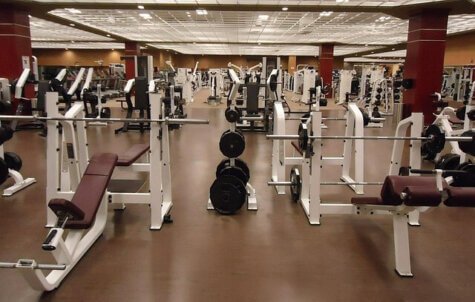Muscle mass refers to the total amount of muscle in your body, including skeletal muscles, smooth muscles (like those in your organs), and cardiac muscle (heart muscle). However, when people talk about muscle mass in fitness, they usually mean skeletal muscle mass, which is the muscle attached to your bones that helps with movement, strength, and endurance.
WHY IS MUSCLE MASS IMPORTANT?
Strength & Performance – More muscle means better physical performance in sports, weightlifting, and daily activities.
Metabolism Boost – Muscle burns more calories than fat, even at rest, helping with fat loss and weight management.
Injury Prevention – Strong muscles support joints and reduce the risk of injuries.
Aging & Longevity – Maintaining muscle mass helps prevent age-related muscle loss (sarcopenia), improving mobility and independence.
Improved Body Composition – Higher muscle mass means a lower body fat percentage, leading to a leaner and more defined physique.
HOW TO BUILD MUSCLE MASS?
Strength Training – Lifting weights, resistance exercises, and bodyweight training.
Protein Intake – Consuming enough protein to support muscle repair and growth.
Caloric Surplus – Eating more calories than you burn (with a focus on quality nutrition).
Recovery & Sleep – Muscles grow during rest, so getting enough sleep and recovery time is essential.
BUILDING MUSCLE (HYPERTROPHY) INVOLVES A COMBINATION OF PROGRESSIVE RESISTANCE TRAINING, PROPER NUTRITION, AND ADEQUATE RECOVERY. HERE’S A DEEP DIVE INTO THE KEY ASPECTS:
STRENGTH TRAINING FOR MUSCLE GROWTH
Muscles grow through a process called hypertrophy, which happens when they are stressed by resistance (weights, bodyweight, resistance bands) and then repaired to be stronger and larger.
Types of Strength Training for Muscle Mass
Hypertrophy Training (Muscle Size)
Reps: 6-12
Sets: 3-5
Rest: 30-90 seconds between sets
Weight: Moderate to heavy (70-80% of your 1-rep max)
Best for: Maximizing muscle growth
Strength Training (Pure Strength, Less Size)
Reps: 3-6
Sets: 4-6
Rest: 2-5 minutes
Weight: Heavy (80-90% of 1-rep max)
Best for: Increasing overall strength
Endurance Training (Toning, Less Mass)
Reps: 12-20
Sets: 2-4
Rest: 30-60 seconds
Weight: Light to moderate (50-60% of 1-rep max)
Best for: Toning muscles and muscular endurance
PROGRESSIVE OVERLOAD – KEY TO GROWTH
Muscles adapt to stress, so you need to gradually increase the resistance to keep growing. Ways to do this:
Increase weight over time
Increase reps with the same weight
Improve form and technique
Decrease rest time between sets
Use advanced techniques like drop sets, supersets, or tempo training
NUTRITION FOR MUSCLE GROWTH
Muscle isn’t built just in the gym—it’s built in the kitchen too. Proper nutrition fuels growth, repairs tissues, and optimizes performance.
Macronutrients for Muscle Gain
Protein (Key for Muscle Repair & Growth)
Target: 0.7-1g per pound of body weight
Sources: Chicken, beef, fish, eggs, dairy, tofu, lentils, protein shakes
Carbohydrates (Fuel for Workouts & Recovery)
Target: 2-3g per pound of body weight
Sources: Rice, potatoes, oats, fruits, whole grains
Fats (Hormonal Balance & Recovery)
Target: 0.3-0.5g per pound of body weight
Sources: Nuts, seeds, olive oil, avocados
Meal Timing & Frequency
Pre-Workout: Carbs + protein (for energy & muscle protection)
Post-Workout: High-protein + fast-digesting carbs (to promote recovery)
Before Bed: Casein protein (e.g., cottage cheese) to prevent muscle breakdown overnight
Supplements That Help
Whey Protein: Easy way to hit protein targets
Creatine Monohydrate: Increases strength & muscle size
BCAAs/EAA: Helps with muscle recovery (useful if training fasted)
Beta-Alanine: Improves endurance during workouts
Fish Oil: Reduces inflammation & improves joint health
RECOVERY – THE OVERLOOKED MUSCLE BUILDER
Training breaks down muscle fibers—recovery is when they grow bigger and stronger.
Key Recovery Strategies
Sleep: 7-9 hours per night (growth hormone is released during deep sleep)
Rest Days: Muscles need time to repair, so at least 1-2 days per week should be rest or active recovery
Hydration: Water helps transport nutrients & remove waste from muscle cells
Stretching & Mobility Work: Prevents injury & keeps muscles functioning properly
TRAINING SPLITS – STRUCTURING YOUR WORKOUTS
Different workout plans fit different goals. Here are some popular training splits:
Full-Body Routine (3-4 days/week)
Best for beginners or busy schedules
Covers all muscle groups in one session
Upper/Lower Split (4 days/week)
Day 1: Upper Body
Day 2: Lower Body
Day 3: Rest
Day 4: Upper Body
Day 5: Lower Body
Push/Pull/Legs (PPL) (6 days/week)
Day 1: Push (Chest, Shoulders, Triceps)
Day 2: Pull (Back, Biceps)
Day 3: Legs (Quads, Hamstrings, Glutes)
Repeat
Body Part Split (Bro Split) (5-6 days/week)
Day 1: Chest
Day 2: Back
Day 3: Legs
Day 4: Shoulders
Day 5: Arms
AVOIDING COMMON MISTAKES
Not Eating Enough – You can’t build muscle in a calorie deficit.
Lifting Too Light – You need progressive overload for growth.
Overtraining – Muscles grow with rest, not excessive daily lifting.
Skipping Compound Movements – Exercises like squats, deadlifts, and bench press build the most muscle.
Neglecting Form – Poor form leads to injuries and less muscle activation.
Not Tracking Progress – Logging your workouts ensures progress.
HOW LONG DOES IT TAKE TO BUILD MUSCLE?
Muscle growth is a slow process—expect 0.5 to 2 pounds of muscle gain per month with consistent training and diet. Beginners may gain muscle faster, while advanced lifters see slower progress.
PEOPLE OF ALL AGES CAN GAIN MUSCLE MASS, THOUGH THE PROCESS VARIES DEPENDING ON AGE, GENETICS, AND LIFESTYLE FACTORS.
Muscle growth (hypertrophy) is possible at any stage of life, but how quickly and efficiently it happens depends on factors like hormone levels, activity level, and nutrition.
MUSCLE GROWTH AT DIFFERENT AGES
Children & Teenagers (Under 18)
Can build muscle but should focus on bodyweight exercises, light resistance, and proper technique before lifting heavy.
Strength training helps with bone density, coordination, and injury prevention in sports.
Hormones (testosterone and growth hormone) increase during puberty, which can boost muscle growth.
Young Adults (18-30)
Prime years for muscle growth due to high levels of testosterone, growth hormone, and metabolism.
Progressive overload and proper diet yield fast muscle gains.
This is when strength and performance peak, making it the best time for serious muscle-building efforts.
Middle Age (30-50)
Muscle growth is still very possible, but metabolism slows down, and recovery takes longer.
Strength training is critical to prevent muscle loss (sarcopenia), which starts around age 30 at a slow rate.
Prioritizing compound exercises, proper protein intake, and recovery helps maintain and build muscle.
Older Adults & Seniors (50+)
Absolutely can still gain muscle, even in their 70s and beyond.
Strength training helps reduce muscle loss, improve bone density, balance, and prevent falls.
Studies show that even people in their 80s can build muscle with resistance training.
Recovery takes longer, so more rest and mobility work are needed.
HOW OLDER ADULTS CAN MAXIMIZE MUSCLE GROWTH
Strength Train 2-4 Times per Week
Focus on compound movements (squats, deadlifts, presses, rows).
Use progressive overload (increase weights, reps, or intensity gradually).
Prioritize Protein Intake
Older adults need more protein because the body becomes less efficient at using it.
Aim for 0.6-0.8g of protein per pound of body weight.
Don’t Neglect Recovery
Sleep is crucial for muscle growth.
Stretching & mobility work prevent injuries.
Stay Consistent
Muscle can be built at any age, but consistent training and diet are key.
People of all ages can build muscle!
It may take longer for older adults, but resistance training, proper nutrition, and rest make it possible.
The sooner you start, the easier it is to maintain muscle mass long-term.
MUSCLE MASS IS CRUCIAL FOR OVERALL HEALTH, PERFORMANCE, AND LONGEVITY. MANY PEOPLE ASSOCIATE MUSCLE BUILDING WITH BODYBUILDERS, BUT IN REALITY, MUSCLE IS ESSENTIAL FOR EVERYONE, REGARDLESS OF AGE OR FITNESS LEVEL. MORE PEOPLE SHOULD UNDERSTAND ITS IMPORTANCE BECAUSE IT IMPACTS ALMOST EVERY ASPECT OF LIFE, FROM DAILY ACTIVITIES TO LONG-TERM HEALTH.
WHY MUSCLE MASS IS SO IMPORTANT
INCREASES STRENGTH & FUNCTIONAL ABILITY
Muscle allows you to lift, carry, push, and pull without excessive strain.
Everyday tasks (lifting groceries, climbing stairs, playing with kids) become easier.
Reduces the risk of falls and injuries, especially as you age.
PREVENTS AGE-RELATED MUSCLE LOSS (SARCOPENIA)
After age 30, muscle naturally declines at a rate of 3-8% per decade if not maintained.
By age 60+, muscle loss accelerates, leading to weakness, frailty, and loss of independence.
Strength training prevents and even reverses sarcopenia, keeping people strong and mobile.
BOOSTS METABOLISM & FAT LOSS
Muscle is metabolically active, meaning it burns more calories than fat, even at rest.
The more muscle you have, the higher your resting metabolic rate (RMR).
Helps with weight management and fat loss without extreme dieting.
PROTECTS BONE HEALTH & PREVENTS OSTEOPOROSIS
Strength training increases bone density, reducing the risk of fractures.
More muscle means stronger bones, joints, and better posture.
Especially important for women post-menopause, as they are at higher risk for osteoporosis.
IMPROVES INSULIN SENSITIVITY & BLOOD SUGAR CONTROL
More muscle means better glucose uptake, reducing diabetes risk.
Strength training helps manage blood sugar and insulin levels, preventing type 2 diabetes.
ENHANCES MENTAL HEALTH & CONFIDENCE
Strength training reduces stress, anxiety, and depression by releasing endorphins.
Seeing progress in strength and muscle boosts self-confidence.
A strong body often leads to a strong mindset in other areas of life.
SUPPORTS HEART HEALTH & LONGEVITY
Studies show that higher muscle mass is linked to a lower risk of cardiovascular disease.
Stronger muscles mean a stronger heart, as resistance training improves circulation and blood pressure.
Having more muscle is linked to a longer lifespan and a better quality of life.
Helps with Injury Prevention & Faster Recovery
Strong muscles protect joints and ligaments from injuries.
If injuries do occur, people with higher muscle mass recover faster.
WHY MORE PEOPLE SHOULD KNOW THIS
Many still think muscle is just for bodybuilders – but it’s essential for everyone.
Aging populations are at risk of muscle loss and weakness – knowing this can help them stay strong.
Weight loss myths focus too much on cardio – but building muscle is more effective for long-term fat loss.
Most chronic diseases (diabetes, osteoporosis, heart disease) are preventable with muscle maintenance.
It’s never too late to start building muscle – even older adults can benefit significantly.
Muscle mass isn’t just about looks—it’s about strength, health, and longevity. More people should focus on maintaining and building muscle to live longer, move better, and feel stronger every day.
THE TIME IT TAKES TO GAIN MUSCLE MASS FROM A FULL-BODY WORKOUT WITH WEIGHTS THREE TIMES A WEEK DEPENDS ON SEVERAL FACTORS, INCLUDING NUTRITION, TRAINING INTENSITY, SLEEP, AND GENETICS.
However, most people can start seeing noticeable muscle gains within 4 to 8 weeks, with significant results in 3 to 6 months if they remain consistent.
GENERAL TIMELINE FOR MUSCLE GROWTH
Timeframe What Happens? Weeks 1-4 Neurological adaptations – Strength improves, but visible muscle growth is minimal. Weeks 4-8 Muscles start to look slightly fuller and harder. 3-6 months Noticeable size and strength gains, assuming proper diet and training intensity. 6-12 months Significant increase in muscle mass, especially for beginners. 1+ year Steady, slower gains; muscle growth is more noticeable over time.
FACTORS AFFECTING MUSCLE GROWTH
TRAINING EFFECTIVENESS
Progressive overload is key – Increase weight, reps, or intensity over time.
Rest & Recovery – 48 hours between sessions allows muscles to repair and grow.
Full-body workouts (3x per week) are great for beginners and intermediate lifters.
NUTRITION
Protein intake: Aim for 0.7-1g per pound of body weight.
Caloric intake: Eating in a slight calorie surplus (200-300 calories/day) speeds up muscle gain.
Carbs & fats: Essential for energy and recovery.
SLEEP & RECOVERY
Muscles grow outside the gym, not during the workout.
7-9 hours of sleep per night maximizes recovery and growth.
EXPERIENCE LEVEL
Beginners can gain 1-2 lbs of muscle per month in the first 6 months.
Intermediate lifters gain muscle slower (0.5-1 lb per month).
Advanced lifters gain even slower but can still make progress.
IF YOU DO FULL-BODY WEIGHT TRAINING THREE TIMES A WEEK, EXPECT TO SEE:
Strength improvements in 2-4 weeks
Visible muscle definition in 4-8 weeks
Noticeable size gains in 3-6 months
Staying consistent, eating enough protein, and progressively overloading your lifts will maximize results.
BODYBUILDERS AND SERIOUS FITNESS ENTHUSIASTS GO ABOVE AND BEYOND THE STANDARD APPROACH BY FOCUSING ON MORE ADVANCED TRAINING, STRICT NUTRITION, RECOVERY OPTIMIZATION, AND SOMETIMES SUPPLEMENTATION. HERE’S HOW THEY MAXIMIZE MUSCLE GROWTH BEYOND A BASIC FULL-BODY ROUTINE.
HOW BODYBUILDERS & SERIOUS LIFTERS MAXIMIZE MUSCLE GROWTH
ADVANCED TRAINING TECHNIQUES
✔ Higher Training Frequency & Split Routines
- Instead of full-body 3x per week, they do body part splits (e.g., push/pull/legs or bro-split).
- Example:
- Monday: Chest & Triceps
- Tuesday: Back & Biceps
- Wednesday: Legs
- Thursday: Shoulders & Abs
- Friday: Arms & Calves
- Saturday: Legs or Weak Point Training
- Sunday: Rest
✔ Progressive Overload with Periodization
- Constantly increasing weights, reps, or volume to keep pushing muscles.
- Using strength cycles (heavy lifting for a phase, then hypertrophy focus, then deload).
✔ Training to Near Failure
- They train close to failure on most sets (1-2 reps left in the tank).
- Heavy compound lifts (squats, deadlifts, bench press, overhead press) are prioritized.
✔ Intensity Techniques for Extra Growth
- Drop Sets – Reduce weight and continue lifting after reaching failure.
- Super Sets – Two exercises back-to-back with no rest.
- Rest-Pause – Take a short break after failure and push out extra reps.
- Eccentric Training – Slowing down the negative portion of the lift to increase time under tension.
NUTRITION IS DIALED IN
✔ High Protein Intake (1-1.2g per pound of body weight)
- Essential for recovery and muscle repair.
- Sources: Chicken, beef, fish, eggs, whey protein, Greek yogurt, legumes.
✔ Eating in a Caloric Surplus for Bulking
- Lean bulk: 250-500 extra calories/day for slow, lean muscle growth.
- Aggressive bulk: 500-1000 extra calories/day (often leads to more fat gain).
✔ Timed Nutrition & Pre/Post-Workout Meals
- Pre-workout: Carbs + protein for energy.
- Post-workout: Fast-digesting protein + carbs for muscle repair.
✔ Hydration & Electrolytes
- Water intake is 1+ gallon per day.
- Sodium, potassium, magnesium balanced for muscle contractions and endurance.
RECOVERY & OPTIMIZATION
✔ Prioritizing Sleep (7-9 hours per night)
- Growth hormone and testosterone are highest during sleep.
✔ Strategic Rest Days & Active Recovery
- They take 1-2 rest days per week and do light movement on rest days.
✔ Stretching, Mobility Work, and Massage
- Foam rolling, yoga, and stretching to prevent injuries.
- Deep tissue massage or chiropractic care for muscle recovery.
✔ Tracking Progress & Adjusting Accordingly
- They track every workout, weight lifted, and food intake.
- If progress slows, they adjust their diet, rest, or training volume.
STRATEGIC SUPPLEMENTATION
While supplements aren’t required, many bodybuilders use proven ones to enhance recovery and performance:
Supplement Benefit Whey Protein Fast-digesting protein for muscle repair. Creatine Monohydrate Increases strength, power, and muscle hydration. BCAAs (Branched-Chain Amino Acids) Helps reduce muscle breakdown, especially when training fasted. Pre-Workout (Caffeine, Beta-Alanine, Citrulline Malate) Boosts endurance, focus, and blood flow. Fish Oil (Omega-3s) Reduces inflammation and supports joint health. Multivitamins & Electrolytes Covers any vitamin deficiencies from diet.
EXTREME DEDICATION & MENTAL DISCIPLINE
✔ Consistency Above All Else
They train even when tired, sore, or unmotivated.
They plan their meals, workouts, and recovery weeks in advance.
✔ Mind-Muscle Connection
Instead of just moving weights, they focus on feeling each rep and engaging the target muscle fully.
✔ Body Composition Monitoring
Regularly tracking body fat percentage and muscle mass to adjust training/diet.
✔ Long-Term Mindset
Muscle growth takes years, and they embrace the process rather than expect instant results.
HOW THIS COMPARES TO A BASIC 3-DAY ROUTINE
Factor Beginner (3-Day Full Body) Advanced Bodybuilder Training Frequency 3x per week 5-6x per week Workout Volume 3-4 exercises per session 4-6 exercises per muscle group Training Style Basic strength training Advanced hypertrophy techniques Protein Intake 0.7-1g/lb 1-1.2g/lb Caloric Intake Maintenance or small surplus Strategic bulking/cutting cycles Rest & Recovery Basic rest Sleep, mobility, massages, active recovery Supplements Maybe protein Full stack of muscle-building supplements Time to Noticeable Gains 6-12 weeks 3-6 months for significant size
To go beyond basic muscle gain and build serious mass, bodybuilders: ✅ Train with higher volume and intensity using advanced techniques.
✅ Eat high-protein, high-calorie, well-timed meals.
✅ Prioritize sleep, rest, mobility work, and recovery methods.
✅ Use proven supplements to optimize performance.
✅ Stay consistent and disciplined for years.
Building muscle mass is a journey that requires consistency, dedication, and a well-structured approach to training, nutrition, and recovery. Whether you’re a beginner starting with full-body workouts three times a week or someone aiming to push beyond into serious bodybuilding, the fundamentals remain the same—progressive overload, proper protein intake, and sufficient rest. The difference lies in the level of intensity, strategic planning, and long-term commitment that advanced lifters bring to their routines.
Understanding the importance of muscle mass goes beyond aesthetics or strength; it plays a vital role in overall health, longevity, and daily functionality. Increased muscle mass helps boost metabolism, improve joint health, enhance mobility, and reduce the risk of chronic diseases. More people should recognize that muscle is a key component of a healthy body at any age, and it’s never too late to start building strength.
Ultimately, the key to success in muscle growth—whether moderate or extreme—is patience and persistence. Changes don’t happen overnight, but with the right approach, the results will come. Stay consistent, listen to your body, and enjoy the process of getting stronger every step of the way.
THERE ARE SEVERAL GREAT SOURCES WHERE YOU CAN LEARN MORE ABOUT MUSCLE BUILDING, FITNESS, NUTRITION, AND ADVANCED TRAINING TECHNIQUES. HERE ARE SOME RELIABLE PLACES TO CHECK OUT:
1. Reputable Websites & Online Resources
- Examine.com – Science-based supplement and nutrition research.
- Bodybuilding.com – Workout programs, nutrition guides, and expert advice.
- T-Nation – Advanced bodybuilding and strength training techniques.
- StrongLifts – Great for beginners focusing on strength training.
- Precision Nutrition – In-depth guides on nutrition for muscle growth.
- Starting Strength – Best for strength-based training and technique.
2. Books on Muscle Growth & Strength Training
Bigger Leaner Stronger by Mike Matthews – Great for beginners and intermediates.
The New Encyclopedia of Modern Bodybuilding by Arnold Schwarzenegger – A classic.
Starting Strength by Mark Rippetoe – Excellent for building a strong foundation.
The Science and Practice of Strength Training by Vladimir Zatsiorsky – More advanced insights.
Practical Programming for Strength Training by Mark Rippetoe – Programming and long-term progress.
3. YouTube Channels for Training & Nutrition
Jeff Nippard – Science-backed training and nutrition.
Athlean-X (Jeff Cavaliere) – Expert guidance on muscle growth and injury prevention.
Renaissance Periodization – Best for understanding diet, training volume, and recovery.
Juggernaut Training Systems – Strength training and periodization.
More Plates More Dates – Covers supplements, muscle growth, and recovery strategies.
4. Fitness Forums & Communities
Reddit Communities:
- r/fitness – General fitness and strength training.
- r/bodybuilding – Focused on bodybuilding and muscle mass.
- r/weightroom – Advanced strength training discussions.
Online Coaching & Programs
- RP Strength (Renaissance Periodization) – Paid diet and training programs.
- Stronger By Science – Science-based training insights.
- Juggernaut AI – Strength training and hypertrophy programs.
5. Scientific Journals & Research Databases
PubMed (https://pubmed.ncbi.nlm.nih.gov/) – For peer-reviewed studies on muscle growth, protein synthesis, and training.
National Strength and Conditioning Association (NSCA) – Best for certified training insights.
Journal of Strength and Conditioning Research (JSCR) – Covers new studies on resistance training.














